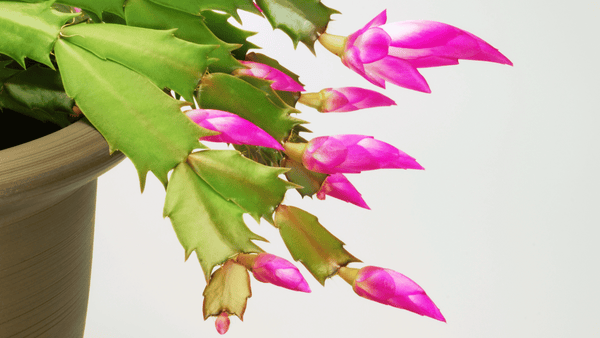
Christmas Cactus – or is it?

How to identify your holiday cactus and give it the care it needs to bloom beautiful flowers!
What are Holiday Cacti?
Holiday cacti are popular houseplants, often given as gifts during the holiday season. They are grown for their beautiful, exotic-looking flowers. Holiday cacti can last a very long time. Some have been said to have lived over 100 years and passed down from generation to generation! These plants are epiphytic cacti native to Brazilian rainforests where they grow on trees like orchids.
Three types of plants are often referred to as Holiday cacti. Christmas and Thanksgiving cacti are in the Schlumbergera genus. Both are short day cacti, which means they need long periods of cool temperatures and darkness to bloom. The Easter cactus is in the genus Rhipsalidopsis or Hatiora.
They are commonly called Thanksgiving, Christmas and Easter cactus only a general reference to the time of year that they may bloom. Their blooms come in a variety of colors. Schlumbergera bridgeseii, more formally known as the Christmas Cactus, has purplish-red flowers; Schlumbergera truncata, often known as Thanksgiving and also Christmas Cactus comes in white, pink, salmon, orange, and yellow; and Easter cactus, known as Rhipsalidopsis gaertneri, can have pink, orange, red, or white flowers.
How to tell the difference between holiday cacti
Schlumbergera truncata has clawed edges on its leaves and is sometimes called Crab cactus. Schlumbergera bridgesii has notched edges but they are not as pointed. Aside from the leaf differences between holiday cactus, both are generally quite similar, with tubular, brightly colored flowers. Easter cactus plants have flat, star shaped flowers, easy to set apart from the other holiday cacti’s elongated blooms.
Schlumbergera truncata is very often sold as Christmas cactus in Canada. The reason that Schlumbergera truncata are more popular in Canada and often sold as Christmas cactus is that they bloom closer to actual Christmas, and they bloom a bigger variety of colors. Most people have the Schlumbergera truncata, which bloom for a longer period, between November and January. Schlumbergera bridgeseii bloom in late December, and Easter cacti bloom in April/May.

The real difference between each species is in their leaf stem segments, or pads. Look at the shape of the stem segments and take note of what season the plant is blooming in. Regardless of their designation, holiday cacti are easy to grow and will produce blooms annually provided they have their low temperature, dim light period.
Caring for your Christmas Cactus
Follow these tips to ensure proper care and a long life of any of your holiday cacti.
Light: Christmas cactus prefers bright, indirect light. Avoid placing it in direct sunlight, which can cause leaf burn.
Water: Christmas cactus prefers to be kept evenly moist but not waterlogged. Allow the top inch of soil to dry out before watering. Overwatering can cause root rot.
Temperature: Christmas cactus prefers temperatures between 16-21°C (60-70°F). Avoid placing it in a drafty area or near a heat source.
Soil: Christmas cactus ideally needs a soil with plenty of organic matter, slightly acidic and with good drainage. A commercial potting mix or a mix of equal parts peat moss, coarse sand, and loam works well.
Fertilizer: Feed your Christmas cactus every 2-4 weeks during the growing season (April-September) with a balanced, water-soluble fertilizer.
Repotting: Repot your Christmas cactus every 2-3 years in spring, using a slightly larger pot and fresh potting mix.
Pests & Diseases: Christmas cactus is relatively pest and disease-free, but watch out for mealybugs, spider mites, and scale insects. These can be treated with a mild solution of water and dish soap.
How to encourage blooming of Christmas Cactus
We will talk about the Schlumbergera truncata since it is the most common plant sold as Christmas cactus in Canada. You can expect this Christmas cactus to start blooming anywhere from early November to late December. However, it's important to note that individual plants may have slight variations in their blooming schedule. Providing the right conditions, including cooler temperatures and shorter daylight hours, can help encourage flowering.

To promote blooming, you can:
Provide Cool Temperatures: Keep the plant in a location where the temperature ranges from 13-18°C (55-65°C) during the day and slightly cooler at night.
Limit Daylight Exposure: Starting in late September to early October, provide the plant with 12-14 hours of darkness each night for about 6 weeks. This can be achieved by placing it in a dark room or covering it with a light-blocking material in the evening.
Maintain Adequate Light: During the day, place the cactus in a location with bright, indirect light. Avoid direct sunlight, especially in the afternoon.
Proper Watering: Water the plant thoroughly but allow the top inch of soil to dry out before watering again. Overwatering can inhibit blooming.
Remember that these are general guidelines and individual plants may have their own unique blooming patterns. With the right care, your Christmas cactus should produce beautiful blooms in the late fall to mid-winter in Canada.
Conclusion
In Canada, Schlumbergara truncata are normally sold as Christmas cactus because they bloom for longer periods and offer a broader variety of colours. Most people who have a Christmas cactus have this variety. Schlumbergera is a beautiful and beloved houseplant adapted from epiphytes from the Brazilian tropical forests. They make a wonderful welcome gift in winter when it’s cold and snowy outside, with shorter days. Many families have Thanksgiving and Christmas cacti that have come down to them from grandparents and even great grandparents!
With a little attention to their care and needs, anyone can have a Christmas cactus for some winter cheer and perhaps to start a family heirloom plant to pass on to future generations.
Cactus en Ligne Team
